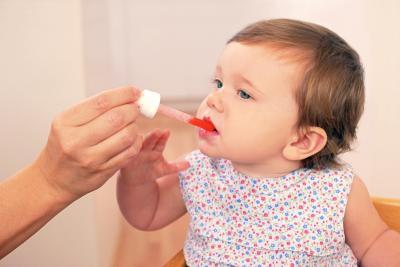Fevers in Toddlers and Babies
Common Illness in Children
Fever, 3 and Younger
Fever is the body's normal and healthy reaction to infection and other illnesses, both minor and serious. Fevers help the body fight infection. Fever is a symptom, not a disease. In most cases, fever means your child has a minor illness. Often you must look at your child's other symptoms to determine how serious the illness is.
Normal body temperature
The average normal body temperature is about 98.6° F (37° C). It usually rises during the day from a low of 97.4° F (36.3° C) in the morning to a high of 99.6° F (37.6° C) in the late afternoon. Each child has a normal temperature range that may be different from another child's. Mild increases to 100.4° F (38° C) can be caused by exercising, wearing too many clothes, taking a hot bath, or being outside in hot weather.
Fever
Temperature varies depending on how you take it. The most common ways to measure it are:
- Under the tongue.
- In the armpit.
- In the rectum.
- In the ear.
You can also use:
- Forehead temperature strips.
- Pacifier thermometers.
Some methods may not be as reliable or accurate as others. For information about taking accurate temperatures, see the topic Body Temperature.
If you think your child has a fever but you are not able to measure his or her temperature, it is important to look for other symptoms of illness.
As a general rule, the younger your child, the sooner you will need to get him checked out. Here's when the American Academy of Pediatrics recommends you contact your child's doctor:
• Under 3 months: Any fever of 100.4°F or higher, even if he shows no other symptoms of illness. If the fever develops after office hours or on a weekend, go to the emergency room. Young babies have a limited ability to fight illness because their immune system isn't fully developed. Young babies can’t tell you if they are really sick and there are some serious bacterial infections that they are more prone to, like kidney infections, blood stream, and pneumonia.
• 3 to 6 months: A fever of 101°F or higher.
• Over 6 months: A fever 103°F or higher.
• A fever in any age child measuring between 104ºF (40.0ºC) and 105ºF (40.6ºC)
• Fever in a child over three months of age without an obvious source (accompanied by common cold symptoms, diarrhea, etc)• Fever more than 3 consecutive days with an obvious source of infection or any fever without an obvious source of infection
• Any fever and sore throat that lasts more than 24 to 48 hours
• You see signs of dehydration, such as a dry mouth, a sunken soft spot, or fewer wet diapers (less than one every 8 hours)
• Your child has a fever and pain when urinating
• Your child is lethargic, refuses to eat, has a rash, or is having difficulty breathing
• Your child has a febrile seizure
• Your child has a fever and has recently returned from a trip abroad
Seek immediate medical help if your child has:
• A fever and is under 3 months old
• A fever of 105ºF (40.6ºC) or higher
• A fever and obvious breathing difficulties
• A fever and is having trouble swallowing to the point where she is drooling because she is unable to swallow her own saliva
• A fever and is still lethargic or listless even after taking fever-reducing medication
• A fever accompanied with a headache, stiff neck, or purplish patches or tiny red spots on the skin
• A fever and severe pain
• A febrile seizure lasting 15 minutes or more
• A febrile seizure and he's having trouble breathing afterwards
• A fever and has compromised immunity (i.e. if the child is on chemotherapy for cancer)
Childhood immunizations can reduce the risk for fever-related illnesses, such as Haemophilus influenzae type b(Hib) infection. Although no vaccine is 100% effective, most routine childhood immunizations are effective for 85% to 95% of the children who receive them.
Causes of fever
It is not unusual for a preschool-aged child to have 7 to 10 viral infections in a year. Each new viral infection may cause a fever. It may seem that a fever is ongoing, but if 48 hours pass between fevers, then the new fever is most likely from a new illness.
Common causes of fever include:
- Viral infections, such as colds, flu, and chickenpox.
- Bacterial infections, such as a urinary tract infection.
- Immunizations.
Teething does not cause a fever. If a baby is teething and has a fever, look for other symptoms that may need to be evaluated.
A fever that increases quickly may lead to a fever seizure in some children. After a fever has reached a high temperature, the risk of a seizure is less. Fever seizures can be frightening to see, but they usually do not cause other problems, such as brain damage, intellectual disability, or learning problems.
Consult an ER immediately if you child exhibits signs of breathing difficulty, bluish color skin, lethargy that is not normal and extreme, signs of dehydration
Consult your primary care physician or and pediatrician anytime your child or baby has a fever that causes you concern.





